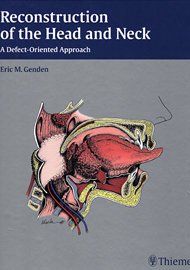This is the second Thieme book on head and neck cancer by this author that follows on from Head and Neck Cancer: an Evidence-Based Team Approach four years ago. It is a well-structured, up-to-date book in a readable layout with good colour illustrations throughout. It is divided into ten chapters in less than 200 pages covering the range of defects that present in the head and neck region.
The basic format for most chapters is an introduction to the anatomy of the region followed by classification of the defect. The options of reconstruction for each defect are then considered, from simple to more involved, and a brief mention is made of the surgical technique, considerations and key factors in patient selection and management.
Reconstruction of the Head and Neck: A Defect-Oriented Approach starts with chapters on the oral cavity and bony reconstruction of the mandible and maxilla, before moving on to the pharynx and neck. Mention is made of the importance of non-surgical factors that improve surgical results such as optimal nutrition for healing and attention to the thyroid status in post-radiotherapy patients. Of particular interest are chapters on facial paralysis and paediatric reconstruction. The chapter on facial paralysis is particularly good and contains a classification of smile patterns.
The final chapter provides an excellent synopsis of the principles of micro-vascular anastomosis in head and neck reconstruction. The classification of the vascular neck into zones and attention to vessel preparation for anastomosis is highlighted, a topic overlooked by many head and neck surgeons not involved with reconstruction.
This is not a textbook on ‘how to do it’ but more about the options and general principles of reconstruction of defects at various head and neck sites. There are other more detailed texts dealing with surgical techniques. There seems to be an overuse of the word excellent to describe post-surgical results, where perhaps more modest terms such as good or acceptable may have been more appropriate.
I would rate this book as 4/5 and feel that it would serve as a useful addition to the library of the head and neck surgeon or trainees with an interest in this field.




